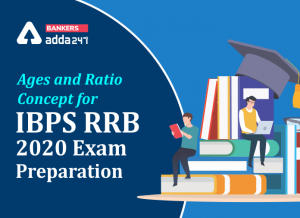Quantitative Aptitude for Govt Exams
Quantitative Aptitude is hard in most cases especially in exams like Banks and Insurance. Many Banks exam has a two-tier examination pattern i.e., Prelims and Mains. Most of them have changed their exam patterns and set a sectional timing of 20 minutes on each section. Quantitative aptitude is important for every exam because proper strategy and enough practice can help you score full marks in this section. There may not be assured in the language section and you may be stuck while solving reasoning questions but quants is a scoring subject and assure full marks if the calculation is correct.
So to help you ace the quants and to save your precious time during exam hours Adda247 providing some quant tricks to help aspirants.
Percentage concept-
A) 1/3= 1/3*100=33.33%( Recurring decimal)
2/3= 2*33.33%=66.66%,
4/3= 4* 33.33 but this is not easy we can write it as (1+1/3)*100=100%+33.33=133.33
B) 1/4= 25%
3/4=3*25%=75%,
5/4 is improper fraction, split it into= (1+1/4)*100=100%+25%=125%
6/4= 3/2*100=150% or if you know table of 25 then directly 6*25=150
7/4= split it (1+3/4)*100=175% or 25*7=175
C) 1/5= 20%,
2/5=40%,
3/5=60%,
4/5=80%,
6/5= 120%
D) 1/6=16.66% or 162⁄3
2/6=1/3=33.33%,
5/6=5*16.66=83.33% or we can break it into (1-1/6)*100=100%-162⁄3=831⁄3
7/6=(1+1/6)=116.66%
Note- 100-162⁄3= subtract 17 from the 100 and then subtract 3-2.
all the subtraction in fractions happens as above
E) 1/7=14.28% or 142⁄7,
2/7=28.56 %
3/7= we multiply 3*14 2/7= 3*(14+2/7)%= 42%+6/7%=42.85
4/7=4*(142⁄7)=56+8/7=57 1/7
6/7= 1-1/7=100-142⁄7=855⁄7
F) 1/8= 12.5%,
3/8=37.5%,
5/8= 62.5%,
7/8=(1-1/8)=100%-12.5=87.5%
9/8=(1+1/8)*100=112.5%
G) 1/9= 11.11%,
2/9=22.22,
4/9= 44.44%,
5/9=55.55%,
6/9=66.66%
[ Note the trend]- same value before and after decimal
H) 1/10=10%
I) 1/11=9.09%,
2/11= 18.18%, 3/11=27.27%, 4/11= 36.36 [ Note the trend]- same value before and after decimal
J) 1/12=8.33%, 5/12= 41.66 [ Recurring]
K) 1/13= 79⁄13%
L) 1/14=72⁄14, 3/14=21.42%
M) 1/15=610⁄15=62⁄3=6.66 or divide and multiply by 2 in numerator and denominator=2/30, 4/15=8/30
Note- if denominator has 5 in its unit place make it 10.
N) 1/16=64⁄16=6.25, 3/16=18.75, 5/16= 5*(6.25)=31.25
O) 1/17=515⁄17
P) 1/18=55⁄9
Q) 1/19=55⁄19
R) 1/20= 5%
Start with some previous concepts-
the main confusion among students is what is the denominator in the above questions. Many times student get confused and wasted a lot of time
the number or value always after “of “and “than” comes in denominator.
Example1- A is 25% more than b, then b is what % less than a
Method 1- let b is 100, then a is 125
b is what % less than a = 125-100/125=25/125*100=20%
Method 2- 25%=1/4
if b=4 then 1/4*4=1
a=5
a/b=5/4 then b is what % less than a=1/5*100=20%
Best approaches-
Method 3– shortcut
if a is increased by (1/n)% then to compensate we have to decrease the value of b by (1/n+1)%
increase of 25% =1/4 here n=4 then b is decreased by 1/(4+1) i.e. 1/5 or 20%
New concept– if first value is x% more than the second value, then the second value is (x/100+x)% less than the first value
Now above question can be solved in mind by this formula-
A is 25% more than B then B is what % less than A
Putting value= 25/125*100=20%
Here the % value increased is easy we can easily divide but see the next example
Example 2- A is 87.5% more than B then B is what % less than A
Best Approaches-
method1- Putting value=(87.5/100+87.5)*100=(87.5/187.5)*100 is difficult task
we do it by fraction value
87.5%=7/8, Or we write 87.5%=100%-12.5=1-1/8=7/8
So here x=1/8
We can write 187.5%(100%+87.5%)=1+7/8=15/8
Now (87.5/100+87.5)*100= (7/8)/15/8=7/15
Method 2- if a is increased by (1/n)% then to compensate we have to decrease the value of b by (1/n+1)
here a is increase by1/ n=1/(8/7) then b is decreased by (1/(8/7+1)
i.e. b is decreased by 7/15.
Concept 2– If the first value is x% less than the second value then, second value is (x/100-x)*100
Examples1. when A is 20% less than B then B is what % more than A.
Method 1-Putting value in the above formula 20/80*100=25%
Method 2- here a is decreased by (1/n+1)% then to compensate we have to increase the value of b by (1/n)
here (n+1)=5 then to compensate we have to increase the value by (n) i.e. 4 so b is more than a by 25%.
Another approach–
Another approach–
Method 4- Ratio method
20%=1/5 when b is 5 then 5*1/5=1
a is 20% less than b then a= 4
we write a/b=4/5, 1/4*100=25%
Example2- A is 12.5% less than B then B is what % more than A.
Method1- putting value=(12.5/100-12.5)*100=(12.5/87.5)*100=14 2/7%
Method2- here (n+1)=1/8 to compensate B is increased by (n) i.e. 1/7 or 14 2/7%
Concept 3– If the value is first increase by x% and later decreased by x%, the net change in always a decrease which is equal to x% of x or (x)^2/100
Example1- A shopkeeper marks the price of his goods 12% higher than its original price. After that, he allows a discount of 12%. What is his percentage profit or loss?
Solution- In this case, there is always a loss.
% value of loss=(12)^2/100=1.44%
Example2- If the population of a town is increased by 15% in the first year and is decreased by 15% in the next year, what effect can be seen in population?
Solution- there is a decrease of (15)^2/100 %=2.25%
Concept 4– Concept of Successive
a) If the value is increased successively by x% and y% then the final increase is given by
(x+y+xy/100)
b) If the value is increased by x% and decrease by y% then the final is given by
x-y-xy/100
c) if both the value is decreased by x% and y%
-x-y+xy/100
Use of successive concept- Successive is used in Percentage, Profit and loss, Compound Interest, Geometry and in data interpretation.
Example1- If the price is increased by 10% and the sale is decreased by 5% then what will be the effect on income?
Solution- Price and Sale(consumption) are inversely proportional to each other
If price increase then sale(consumption) decrease and vice versa
in this question +10%-5%-50/100=4.5% increase in his income.
Successive concept in 2-D Geometry
Example- If one side of a rectangle is increased by 20% and the other side is decreased by 5%, find the percent value by which the area changes.
Solution– % effect in the area= +20%-5%-20*5/100=14%.
Concept5– If the sides of a triangle, rectangle, square, circle, rhombus or (any 2-D figure) are increased by x%, its area is increased by –
[2x+ x^2/100]%
Example– If the radius of a circle is increased by 5%, find the percentage increase in the area.
Solution– % increase in its area= 5%+5+25/100=10+0.25=10.25%
Do it for Yourself
1. If the price of a commodity is raised by 20%, find how much percent must a household reduce his consumption of that commodity so as not to increase his expenditure.
2.If the price of sugar falls down by 10%, by how much percent must a householder increase its consumption, so as not to decrease expenditure.
You will post your solutions and methods in the comment section.
You may also like to read-




 Ages And Ratio Concept for IBPS RRB Prel...
Ages And Ratio Concept for IBPS RRB Prel...



